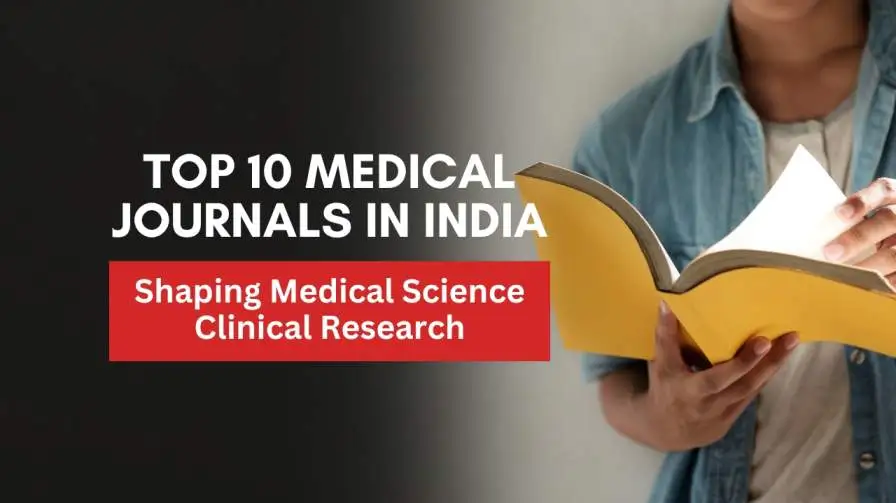Medical journals are great resources for discovering various medical discoveries and improvements in the healthcare sector. In India, there are various reputable journals which have contributed immensely to medical technology and medical studies. These journals serve as preference systems for researchers, practitioners, and college students to take informed decisions with new medical findings, treatment methods, and critical improvements. Let’s delve deeper to discover the top 10 medical journals in India and offer insights into important topics like writing a medical journal reading and critiquing scientific articles, and how to make contributions a piece of writing for these journals.
Table Of Content
Top 10 Indian Medical Journals
1. Indian Journal of Medical Research (IJMR)
The Indian Journal of Medical Research (IJMR) is considered one of India’s most prestigious scientific journals, published by way of the Indian Council of Medical Research (ICMR). It covers diverse clinical disciplines, such as epidemiology, scientific trials, and microbiology, supplying researchers with tremendous, peer-reviewed articles.
2. Asian Journal of Medical Sciences (AJMS)
The Asian Journal of Medical Sciences (AJMS) publishes original studies, review articles, and case research throughout numerous specialties. With a vast target market in Asia and past, AJMS is an excellent help for professionals inquisitive about nearby health issues, including the precise medical challenges confronted by way of Asian populations.
3. Indian Journal of Clinical Practice
Known for its practical approach, the Indian Journal of Clinical Practice makes a specialty of case reports, diagnostic methods, and protocols. This journal is specially treasured for clinical practitioners who are looking to apply modern-day studies in a scientific setting.
4. Indian Journal of Medical Microbiology
This journal emphasizes microbiological studies and is broadly diagnosed for its contributions to infectious illnesses, microbiological diagnostics, and virology. Indian Journal of Medical Microbiology is critical for researchers and clinicians operating in contamination control and public fitness.
5. International Journal of Research in Medical Sciences (IJRMS)
The International Journal of Research in Medical Sciences (IJRMS) is a peer-reviewed, open-get admission to journal that publishes an extensive variety of topics, such as anatomy, biochemistry, and radiology. It is extensively used by researchers international for sharing their findings in diverse clinical science fields
6. Journal of Family Medicine and Primary Care (JFMPC)
This journal makes a specialty of own family medicine, public fitness, and primary care, highlighting community-stage fitness practices and preventive care. Journal of Family Medicine and Primary Care is beneficial for practitioners and researchers who emphasize primary healthcare.
7. Indian Journal of Cancer
The Indian Journal of Cancer addresses oncology research, proposing research on most cancers’ epidemiology, diagnostics, and treatments specific to the Indian populace. As cancer incidence continues to grow in India, this journal provides vital insights for both researchers and oncologists.
8. National Medical Journal of India
Published by the All-India Institute of Medical Sciences (AIIMS), the National Medical Journal of India presents a platform for peer-reviewed articles that develop clinical and biomedical studies. It aims to enhance healthcare regulations and practices in India.
9. Journal of Clinical and Diagnostic Research (JCDR)
The Journal of Clinical and Diagnostic Research covers various specialties, focusing on improving diagnostic accuracy and medical consequences.
10. Journal of the Association of Physicians of India (JAPI)
As one of the oldest clinical journals in India, Journal of the Association of Physicians of India has a strong focus on inner medicinal drug, publishing case reports, research articles, and scientific recommendations. It is popular among physicians for its realistic and proof-based content.
How to Write a Medical Journal Article
Writing a scientific journal article requires clarity, precision, and thorough information of the topic. Here’s a step-by-step guide:
- Identify the Topic and Conduct Research: Choose an applicable topic, subsidized with the help of thorough research. Ensure that your topic fills an understanding gap or provides new insights into current studies.
Follow the IMRaD Structure
Most scientific Medical journals articles use the IMRaD format:
- Introduction: State the hassle, significance, and objective.
- Methods: Describe the have a look at design, members, substances, and approaches.
- Results: Present findings with suitable statistical visualization (tables, graphs).
- Discussion: Interpret findings, examine with beyond studies, and conclude with implications or future studies guidelines.
- Use Precise Language: Medical journals call for accurate language that conveys statistics definitely. Avoid jargon unless essential and give an explanation for complex phrases.
- Cite Sources Properly: Properly cite all resources, following the referencing style given utilizing the journal (e.G., APA, Vancouver). Ensure accuracy in citations to preserve the credibility of your research.
- Review and Edit: Proofread the thing thoroughly to put off mistakes, inconsistencies, and uncertain sections. Seek peer remarks for an objective review of your work.
Where to Find Medical Journals
Accessing clinical Medical journals is critical for staying up to date with current studies. Here’s wherein you could locate creditable journals
- PubMed – A free help that gives entry to MEDLINE, masking a wide spectrum of biomedical research.
- Google Scholar – It aggregates studies papers and clinical journals throughout disciplines, supplying free and subscription-primarily based articles.
- ResearchGate – This platform lets researchers to proportionate and get admission to papers, frequently enabling you to request full-text articles directly from authors.
- National Medical Library of India – India’s number one clinical library gives virtual and bodily resources for medical professionals and students.
- Journal Websites – Visiting the websites of specific journals such as Indian Journal of Medical Research or Journal of the Association of Physicians of India offers direct access to their contemporary guides.
How to Read a Medical Journal Article
Reading a medical journal article efficaciously helps in knowing the core message, strategies, and findings. Here’s how to do it:
- Read the Abstract First: The abstract gives a quick evaluation of the article, outlining the objectives, method, and conclusions.
- Focus on the Introduction and Discussion: These sections will help you understand the context, purpose, and implications of the take a look at.
- Analyze the Methods and Results: Pay interest to the have a look at layout, pattern size, and statistical methods. Reviewing tables, figures, and charts can provide a clearer image of the effects.
- Review the Conclusion and Limitations: Conclusions summarize the important findings, while obstacles spotlight potential weaknesses or areas for additional studies.
How to Write an Editorial for a Medical Journal
Editorials in clinical Medical journals address current issues, moral worries, or improvements in scientific science. Here are some great recommendations
- Choose a Relevant Topic: The subject matter should be able to deal with modern issues.
- State Your Position Clearly: Begin with a concise statement of your stance, accompanied by using a logical progression of arguments assisting your specific point.
- Include Evidence and References: Support your arguments with latest studies, records, or credible resources to depict your editorial’s impact.
- Conclude with Implications: End with a key takeaway or name the crucial implications, highlighting how the topic can influence future research or scientific practice.
How to write a Medical Journal Article
Writing a scientific Medical journals article involves assessing its strengths, weaknesses, and standard contributions to scientific studies. Here’s a way to method it
- Examine the Study Design: Evaluate whether the look at design became appropriate for the research query, inclusive of pattern size, manage organizations, and technique.
- Analyze the Data and Results: Look for readability in the facts presentation and the statistical methods used. Assess if the results are significant and align with the specified objectives
- Review the Discussion and Conclusion: Determine if the authors’ interpretations and conclusions are justified primarily based on the consequences. Consider if they mention barriers or recommend future research.
- Consider the Impact: Reflect on the article’s contribution to the sector and its relevance for future research or medical exercise.
Wrapping Up
These specific scientific Medical journals in India play a crucial position in shaping the healthcare sector by way of facilitating alternative of clinical understanding and providing precious insights for researchers and practitioners. Whether you are a medical student, researcher, or clinician, how the way to navigate, critique, and make contributions to these journals can enhance your scientific know-how and can impact your understanding.
Frequently Asked Question (FAQs)
Each journal has precise submission pointers, usually discovered on its internet site. Generally, you want to put together your article according to the journals formatting regulations, including abstract, key phrases, and references. Then, post it through the journal’s online portal for peer evaluation.
Choose a journal that aligns with your observer's awareness, scope, and meant target market. Review past problems of journals to peer if they publish similar studies and consider factors just like the journal’s impact element, readership, and recognition costs.
Peer assessment is the method of evaluating the best, validity, and significance by using specialists in the same subject. It’s important because it enables ensure that handiest super, credible research is posted.
Credible journals are indexed in recognized databases (like PubMed or Scopus), have obvious editorial rules, a reputable editorial board, and follow a rigorous peer-assessment method. Impact thing and other bibliometric signs can also help gauge credibility.
Many journals provide open-get admission to articles, while some require a subscription. Resources like PubMed, Google Scholar, and ResearchGate regularly have unfastened articles, or you can request the total text from authors if it’s not available.






